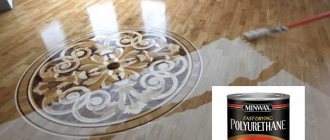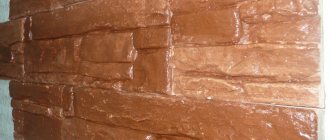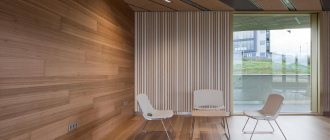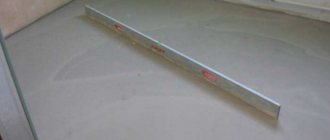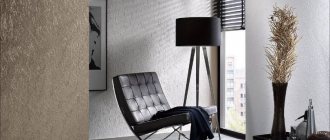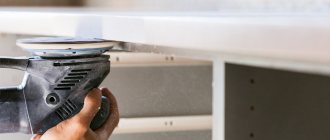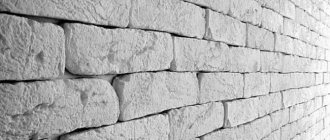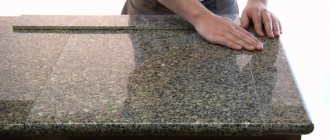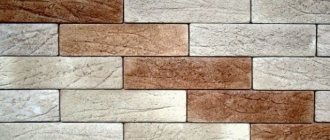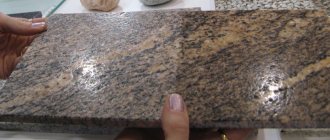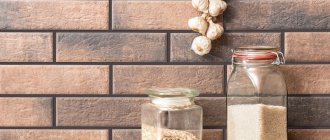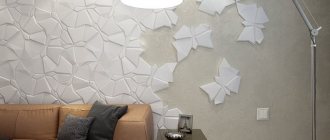The basement is one of the key elements of a newly constructed building.
It is necessary not only to lay the base, but also to select the appropriate decorative cladding. One of the cost-effective and popular solutions is the use of artificial stone. You can choose the material according to the color scheme, texture and format of the tiles.
We will talk about the pros and cons of finishing the base with artificial stone in the article.
What is the material?
This is a decorative material used for cladding the lower part of a country house or residential building, industrial and commercial buildings. It protects against physical and climatic phenomena. Despite its origin, the coating reliably protects the base part from the penetration of water and cold.
The material has a number of advantages:
Availability, which is several times lower compared to natural analogues.- Easy installation thanks to lightweight design and processing capabilities.
- Variety of textures, textures and shades.
- Resistance to changes in humidity and temperature.
- Long service life.
- Significant fire safety.
- When heated, no harmful components are released.
- Environmental cleanliness and safety.
- You can easily keep the coating in order with standard detergents.
As a result, the material of artificial origin retains most of the advantages of natural coating. At the same time, its feature is an expanded selection. color variety and originality of the composition.
Main features of the material
Artificial stone for a plinth is a product that imitates the color and texture of a wide variety of natural materials - from baht and cobblestone to clinker tiles and slate rocks. The material has a number of positive properties, which determined its popularity among a wide range of developers.
No one will argue that the material looks great
Advantages
- Low price, unlike natural analogues, the cost of artificial stone is several times lower. This is an important factor, given that the volumes are quite impressive, and the amount can reach six figures.
- This material is much easier to install due to a number of reasons: the convenience of the fragments and their geometric correctness, low weight and good performance properties.
- A huge selection of structure and color options, you can definitely choose the best option.
- An impressive service life; serious manufacturers provide a guarantee of several decades, which indicates the high quality of the product.
Advice! Choose products from trusted manufacturers. Be guided by the opinions of customers, reviews on the Internet and recommendations of those who work with the material - they will provide the most valuable information.
In the photo - the material is suitable not only for the base, but also for decorating the facade of the house
Requirements for the material
Currently, there are many sellers on the market, and choosing a truly worthy product can be very difficult.
To avoid getting into trouble, it is necessary that the product meets three basic requirements:
- Frost resistance, in our region this is especially important. The material must withstand at least 150 freeze-thaw cycles and retain its original properties - not crack or crumble.
- Strength: Products may not be extremely strong individually, but when laid on a surface they must withstand severe loads.
- Moisture absorption - the lower this indicator, the stronger the material, since it is not saturated with water and will not break when frozen.
Varieties
Manufacturers produce a wide range of materials for finishing the base element. Artificial stone is divided according to decor, internal composition, and color scheme.
The following varieties can be noted:
- flexible;
- cement;
- polymer sand;
- tile;
- homemade.
The choice depends on the installation location and the main material of the facade. The necessary indicators of thermal insulation and protection from the effects of power are taken into account.
Flexible
The material contains 2 layers of polymers. It is available in both piece tiles and rolls. The cladding has the following parameters and advantages:
Light weight.- High flexibility for finishing façade plinths with complex shapes and textures.
- Resistant to steam and moisture.
- Resistance to extreme temperatures.
- Resistance to temperature changes.
- Easy installation.
- One of the most economical materials.
The material is easy to install. It can be cut, including cutting out individual pieces of trim from anywhere. The outer side is additionally protected with film. It is used during transportation, storage, and installation work.
The main disadvantage is the fairly high cost for an artificial composition. Flexible stone is suitable for any base. The main thing is to ensure reliable fixation.
Cement
This is a budget analogue of natural material. Cement facing stone has positive properties:
- resistance to negative temperatures;
- protection from the formation of mold and mildew;
- not affected by precipitation;
- characterized by increased frost resistance and high strength characteristics;
- Long service life with regular and proper care.
If large vertical surfaces are provided, the base is pre-reinforced. The stone is secured to an anchor, as it has a lot of weight. Please note that the finished structure will not adhere to the adhesive composition.
Tile
Base tiles are made from special types of clay . It undergoes high temperature processing. The result is a durable product with high-quality protection against external factors.
The decorative surface can imitate not only natural stone, but also brickwork. As a result, you can choose an option for your own home, taking into account personal preferences, facade decoration, roofing and fence.
The tile has the following parameters and advantages:
- Resistance to thermal influences.
- Increased water impermeability.
- Weather protection.
- Resists temperature changes.
- Retains original shape and appearance.
- Protection from mechanical impact.
The cladding is characterized by long-term operation without additional complications. It is relatively expensive for a material of non-natural origin. At the same time, the quality of the coating is preserved for a long time.
Polymer sand
This is a composite material that is used for finishing facades and basement elements. It is made from a sand mixture with polymer additives and plasticizers. The latter improve the performance of the finished composition. Thanks to the selected composition, a decorative coating appears that replicates the external design and structure of natural stone.
For convenient fastening, the plates are equipped with locking connections. During installation, it is enough to prepare the frame by leveling the surface in one plane. The tiles are secured to the frame using ordinary self-tapping screws. Despite its lightness, polymer sand stone has increased strength characteristics and protects the building from heat loss.
The product has positive characteristics and an affordable price . However, it does not have the flexibility of some artificial materials. For this reason, it is important to prepare the frame in advance to create a level base.
Homemade
This is the most economical, but labor-intensive material for installation. You will need cement mortar to apply to the base. The surface is covered with a thick layer of the mixture. At the final stage, the relief of the stone is drawn using a specialized hook.
Advantages of self-made stone coating:
- reliable adhesion to the surface of the base;
- Durability proven by time;
- No leveling is required before covering with cladding.
The finished result only resembles a stone or copies it exactly. After complete hardening, the surface is coated with paint to give the desired shade. The varnish is then treated for maximum protection.
Types of artificial stone
The range of such facing materials is quite rich. Artificial stone differs not only in color and texture, but also in the type of base material from which the products were made.
Flexible finishing stone
Flexible stone is the latest word in the field of facade cladding. It is a two-layer material. The decorative layer is a thin section of sand agglomerate firmly connected to an adhesive base - acrylic dispersion. Flexible stone has several forms of release - rolls and piece tiles.
Distinctive characteristics that make artificial stone stand out:
- the increased level of flexibility allows you to cladding any plinth, even with complex architectural elements;
- light weight – 3 kg/m2;
- does not burn;
- vapor permeability;
- resistance to moisture;
- not subject to changes due to temperature changes;
- special treatment of the front surface, which gives the finishing material antistatic properties;
- durability;
- ease of installation on any base surface;
- economical consumption.
To these undeniable advantages you can also add a high level of environmental friendliness and a beautiful appearance, thanks to which interior decoration with artificial stone on a flexible basis becomes available.
This material can be cut quite simply with ordinary scissors or a stationery knife. In this case, you can select any elements from the general canvas. This makes it possible to decorate the facade of the building with additional decor, for example, a frame around a window “lined” with flexible stone looks very impressive. When purchasing such material, remember that its front side is protected with a special film, which is removed only after all facade work is completed.
A fly in the ointment of the enviable characteristics of flexible stone is its high cost, comparable to the price of natural stone. If you come across material with a bargain price tag, it is better to inquire about the manufacturer before purchasing.
Artificial stone made of polymer-sand mixture
This type of artificial stone is a composite material made from a special mixture of sand and polymers. This composition makes it possible to produce decorative products that closely replicate the texture of natural stone.
Like the previous type of artificial stone, polymer sand cladding has the same positive characteristics, with the exception of increased flexibility of the product. But if we compare this property with natural or concrete stone, then polymer cladding is more pliable. But one cannot fail to note the increased level of heat capacity of polymer sand stone.
You can make a finishing cladding with this material on absolutely any rough surface. This artificial stone is attached to the base using a wooden or metal sheathing. In addition, it is made in slabs with a tongue-and-groove fastening system to each other, which greatly simplifies the installation process.
Artificial facing stone made of concrete
Concrete plinth stone was one of the first to appear on the market of facade finishing materials and for a long time maintained unprecedented popularity due to its good performance characteristics:
- not susceptible to fungal formations;
- high strength and frost resistance;
- durability with timely repairs;
- not affected by atmospheric phenomena.
A similar facing material is made from a regular sand concrete mixture with the addition of plasticizers. Large-sized products are prudently reinforced. Like any other decorative concrete element, facing stone has significant weight. Therefore, installation with adhesive or cement compositions is effective in rare cases. A more effective method of fastening is with special anchors. But in this case, the decorative layer suffers.
To avoid these negative circumstances, you can purchase concrete products in gray color, install them on anchors, seal small mounting holes with cement paste and paint them in the color you like.
Clinker facing stone
Clinker plinth tiles are made from special types of clay by high-temperature firing. The decorative layer imitates not only a cut of natural stone, but also brickwork. The variety of colors, shapes and textures is amazing.
Clinker tiles are produced both in the form of small-piece products and large-sized panels with a tongue-and-groove assembly method. Piece tiles are very convenient because they are perfectly complemented by corner “bricks”.
This type of plinth cladding with artificial stone is famous for its high performance characteristics:
- heat resistance;
- high degree of water resistance;
- not susceptible to sudden temperature and climatic changes;
- when selecting a high-quality adhesive composition, clinker tiles can stick to it, as they say, “forever”;
- retains its color and original shape for many years;
- withstands any mechanical stress.
The disadvantages include considerable cost. But the unsurpassed performance characteristics and aesthetic qualities more than pay for the high price tag.
Decorative layer of ordinary concrete mortar “like a stone”
Do you need cladding the basement of your house with artificial stone on a budget? Then this method is for you. Concrete mortar is applied in a thick layer to the base, and a stone relief is drawn out with a special hook. After complete hardening, the decorative layer is coated with any color and, if possible, varnish.
A huge advantage of such a coating is that the unevenness of the treated base can not be leveled and can be treated like a textured relief of a stone cut. Another undeniable advantage is reliable adhesion to the base of the building and incomparable durability. The remaining performance characteristics are similar to those of concrete slabs for facade finishing.
I would like to note that when purchasing facade tiles, you need to rely not only on its aesthetics, but also on the design of the foundation, as well as its age.
If you plan to renovate a building “in years,” then before carrying it out you need to carefully examine the foundation. It is recommended to purchase “lightweight” variations of tiles that imitate the natural cut of stone, so as not to burden the foundation structure. If it is intended to cover the basement of a new house, then in this case it is worth starting from the type of foundation itself and the decorative similarity with the main facade.
Nuances of choosing decorative stone
When choosing a material, the following parameters are taken into account:
- Superb view.
- Compliance with installation technology.
- Functional and technological connection with blind areas, since when facing it is important to ensure normal moisture release and thermal insulation.
- Compliance with the architectural solution.
The material meets the parameters of environmental safety and environmental protection. There should be no chips, damage or cracks on the surface. The color of individual strips must match the rest.
Tools and Supplies
Before installation, you need to prepare materials and tools. For quality work you will need:
- trowel;
- mesh for reinforcement;
- concrete solution;
- adhesive composition;
- screwdriver;
- drill or hammer drill;
- composition for jointing;
- dowels;
- building level;
- deep penetration primer.
The exact composition depends on the installation method chosen. Sometimes you have to weld the frame. In other cases, you have to prepare an even coating and glue the prepared strips.
How to cover the basement floor of a private house with your own hands?
The stone of artificial origin is relatively light in weight. For this reason, installation is relatively simple. It is important to first clean the base from uneven surfaces, grease stains, and dirt. It is advisable to align the base element with a deviation of up to 15 mm. If the base is relatively flat, an adhesive composition is used for fastening.
To do this, perform the following steps:
- The base is covered with deep penetration soil.
- Then the notches are made.
- Special glue is applied.
- Attach strips or panels.
This method is suitable for flexible stone or material with low density. In this case, it is important not to apply glue to the entire surface at once, as it dries quickly. It is enough to prepare the stone in advance and cover no more than 1 square meter with glue. m. covering.
Large tiles, such as polymer sand stone, are attached to the frame . It has grooves to tightly connect the tiles to each other. First, a metal or wooden sheathing is installed. After this, fastening with dowels is possible.
Possible errors when facing
When installing artificial stone on a plinth element, it is important to avoid mistakes. This leads to damage to the material, a decrease in decorative properties and performance characteristics.
The following typical errors can be identified:
- Unprepared surface. This is the most common mistake when doing DIY work. It is often believed that if the base is not visible from the outside, it does not need to be cleaned, treated with protective compounds and leveled. This leads to poor grip. In addition, decorative strips cannot be fixed in a single plane.
- Choosing adhesive for interior tiles. Adhesive is often used for ceramic tiles used in interior spaces. It is believed that the façade cladding has a similar coating. The mistake is that the artificial stone is heavier. The adhesive composition for installing stone has high strength and adhesion quality.
- Laying interior stone or gypsum tiles on the plinth. Coatings of this type cannot cope with temperature changes and serious mechanical and physical impacts. They are suitable exclusively for interior work. They are used for the hallway of a bedroom or living room. For external work, a special stone is required.
- Stone of the same series, but from different batches. When ordering several packages, you must ensure that they are marked as being from the same batch. If this is not done, a noticeable color difference may occur.
- Using grout for ceramic tiles. This happens for reasons of economy, as many try to use the remaining material after repairs. For decorative stone, jointing is used. If you use tile grout, it will be absorbed into the surface of the stone, after which you will not be able to correct the situation.
- Purchase of finishing materials without stock. This is a mandatory condition, since during the installation process a certain amount of stone can be damaged. You will need at least 10% of the material for stock.
If you follow simple installation rules, the final surface will look good. It retains its original appearance for a long time. In this case, the protection indicators of the plinth finish will be optimal.
How to finish the base: options for types of materials to finish the base of a house inexpensively
Whatever house is built, its entire structure is always based on a reliable foundation of one type or another. The importance of this structural element simply cannot be overestimated - it is it that takes on and distributes all the main weight loads. As a rule, the foundation always protrudes somewhat above the surface of the earth, forming the so-called basement part. And so the owner of the house inevitably faces the question - how to finish the base?
How to finish the base
There are many options for solving this problem. But first of all, it’s worth figuring out - is finishing the base really necessary?
The content of the article
1 Why is the base lined?2 Types of materials used for finishing the base2.1 Plastering and painting2.2 Finishing the base with natural stone2.3 Video: facing the base with sandstone2.4 Cladding with artificial stone2.5 Finishing the base with brick or “brick-like”2.6 Video: installation of base thermal panels2.7 Finishing with base siding2.8 Video: polymer base siding “under the stone”3 A necessary element for finishing the base is ebb and flow 3.1 Video: installation of metal ebb and flow on the base
Why is the base covered?
Many home owners consider finishing the basement only as a special design touch in the overall exterior design of the house. The desire to make your home as beautiful as possible in appearance is quite understandable and justified, but it turns out that decorativeness in this case, although important, is still secondary. The main purpose of the plinth cladding is still different:
Even such a seemingly indestructible element of a building as the foundation needs protection from external influences. The cladding minimizes the impact of precipitation, high humidity, temperature changes, and direct sunlight on the base material. The walls of the house at the basement level are most susceptible to contamination. The liquid dirt that falls on them always contains a lot of chemically aggressive substances that can cause erosion processes even in monolithic concrete. The base should also be protected from the development of forms of biological life on its surface - mold stains, fungal colonies, insect nests. If possible, it is necessary to provide for insulation of the basement of the building. At first glance, it’s a paradox: why insulate it if all the living spaces are located higher. However, this opinion is wrong:
— The base array itself becomes a very capacious cold accumulator, forming not even a “bridge”, but an entire “highway” for the penetration of low temperatures into the premises, from which even a conscientiously insulated floor of the first floor may not save. A significant part of the energy resources spent on heating will simply be wasted.
— The material from which the foundation is made, be it concrete, brick or stone, under the influence of low winter temperatures can freeze through, which will activate erosion processes and reduce its strength.
So, the conclusion is categorical - the base needs high-quality finishing for both operational and decorative reasons. What type of finish should I choose? This will depend on the design features of the building, the preferences of the homeowner, and his financial capabilities.
We recommend that you familiarize yourself with the material on finishing a house with siding, and the step-by-step technology and description will help you decide on the choice and finishing technology.
In addition, on our portal we have posted detailed instructions for installing siding with insulation - here.
Types of materials used for finishing the base
Plastering and painting
One of the simplest finishing methods is to apply a layer of durable plaster to the surface of the base.
One of the simplest options is plastering the base
This finish will create a good sewn layer, characterized by high vapor permeability. The main advantage of this method is its low cost and availability of materials. Carrying out such work yourself or finding a master plasterer is usually not a big problem. And there are many options for adding decorativeness to such a base.
High-quality plastering and painting will give the base an accentuated neatness
Firstly, it can simply be painted with special durable facade paints. There is a wide range of shades on sale, and there is always the opportunity to choose the one most suitable for the intended exterior design of the building. Secondly, an excellent solution would be to apply a finishing layer of decorative plaster. A wide palette of colors and “rich” textures should satisfy any homeowner’s needs.
Variety of decorative plasters
But that's not all. If you show your imagination, you can give even a simply plastered surface a very original look.
Stone? No, this is a plastered base...
In the photograph the base appears to be trimmed with stone. In fact, each “cobblestone” is nothing more than a pile of ordinary concrete mortar, molded by hand directly on the surface of the base.
…the “cobblestones” of which are sculpted by hand...
To sculpt such “stones” you don’t need any special skill - the main thing is to make a high-quality dense solution. Everything else is the imagination and efforts of the home craftsman. After hardening, all that remains is to decorate with dyes - and the plastered base will become indistinguishable from a stone one.
...and tinted with paint
The disadvantages of the technology for finishing the base with plaster include the comparative fragility of the coating - you will have to constantly monitor the condition of the applied layer and timely repair or update damaged, cracked areas.
Finishing the base with natural stone
This type of finishing can certainly be called “elite”. A building with such a plinth always looks very advantageous, and the natural material has excellent performance characteristics and will last a very long time.
Base with natural stone cladding - looks very rich
For cladding, specially prepared stone slabs are used - slabs, usually 20 ÷ 30 mm thick, which can have either a regular geometric shape or uneven edges, which gives a special decorative effect.
Rectangular slabs of gray granite
The surface of the stone can also be chosen to suit your taste - from polished to mirror-like to rough chipped.
For all the beauty and practicality of this type of base finishing, it also has many disadvantages:
Such cladding has a very significant weight, and therefore puts additional load on the foundation of the building, especially in cases where the base has a large surface area. If finishing with natural stone is planned, this is usually calculated at the building design stage. The large mass of stone slabs also predetermines the increased complexity of their installation. Thus, very often even the highest quality adhesive solution is not enough, so there is a need for additional reinforcement and the use of special stops. Another significant drawback is, of course, the price of the material and the cost of installation work, which are not always available for independent execution.
Even the most inexpensive types of natural stone - shell rock or limestone - cost more than 1200 - 1500 rubles per m². More expensive types include granite and marble, with a polished or chipped surface.
Finishing with polished marble panels
Well, if there is a desire to achieve complete exclusivity, then wealthy homeowners sometimes resort to cladding with materials such as gabbro or even labradorite, the price of which is generally “exorbitant”.
Video: facing the base with sandstone
Cladding with artificial stone
In the case when you really want to use stone cladding for the base, but the material capabilities or design features of the building make this impossible, you can resort to another option - purchase artificial stone.
Finishing with high-quality artificial stone is no different in appearance from natural stone
The cost of the artificial analogue is much less, the mass of the material is not so significant, and the illusion of naturalness is almost complete.
Such material is made on the basis of cement-containing mixtures, often with the addition of light fractions (for example, expanded clay crushed stone), special polymer plasticizers and micro-reinforcing components. Tiles are produced using vibration casting technology in special silicone molds that exactly replicate the natural texture of the stone, or by hyper-pressing.
Laying hyper-pressed tiles “under the stone”
The release form may vary. Thus, piece tiles with standardized correct sizes are widely used. No less popular are sets that are assembled per unit area, the individual tiles of which can have different linear dimensions. This type of finishing of the base is carried out in the usual way - by laying it on construction tile adhesive for external work.
Artificial stone panels of the “Canyon” type
To facilitate the installation of the plinth cladding, you can purchase ready-made artificial stone panels, for example, the “Canyon” type. At the production stage, metal mounting brackets with a precise geometric arrangement are embedded into their concrete structure. These parts allow you to mount ready-made panels on the surface of the plinth not with mortar, but with fasteners - an indisputable advantage, especially when cladding along subsystem guides.
Find out how to install artificial stone with your own hands with detailed instructions from our new article.
If desired, such panels can also be installed on an adhesive solution - brackets bent inward will only increase the reliability of adhesion to the surface.
Another option is that tiles made of artificial stone are attached with reliable polyurethane adhesive to a rigid base, with or without insulation - this can be a slab made of OSB, fiber cement or glass magnesite. Such a substrate greatly simplifies the installation of the cladding and gives it additional thermal insulation qualities.
Rigid base panels
The well-thought-out locking part of the panels completely hides the joints between them, creating the effect of natural stonework. The texture of the outer surface can be chosen to suit your taste - rock, crushed stone, tuff, slate, etc. Mosaic solutions with the inclusion of artificial mini-slabs of a different texture or color are also popular.
Finishing the base with brick or “brick-like”
The severity of the brickwork of the plinth always gives the building a special respectability and is in perfect harmony with any possible type of decoration of the rest of the façade area. To achieve this effect, you can use one of the existing options:
Cladding the base with natural brick. This approach has the advantage that it is possible to create a ventilated gap between the base itself and the cladding, or fill this space with insulating material. In addition, the brick itself will also serve as additional thermal insulation, especially if hollow varieties are used. However, it must be remembered that the brickwork itself will need a strip foundation - this issue should be taken into account when planning construction. Although they do it differently - they create their own support for the masonry, which will subsequently be combined with a concrete blind area around the foundation.
We recommend: DIY sandwich panel house
Brick cladding of the base
Various types of bricks are used for cladding the basement.
- The heaviest - hyper-pressed, characterized by very high strength and extremely low water absorption - something that is especially necessary for the base. You can purchase bricks of a variety of sizes - from the “Russian” standard 250 × 120 × 60 mm to the elongated “American” one.
— The most economical option is sand-lime brick, but it is not particularly popular for such finishing work.
— Ceramic bricks, including clinker bricks, usually have a hollow internal structure, which significantly reduces the weight of the cladding itself and provides a pronounced thermal insulation effect.
However, it is not always possible to make real brickwork and, to be honest, it is not always advisable, because such a decorative effect can be completely achieved by using clinker facing tiles.
A simpler and more affordable option is clinker tiles
The material used to make it is in no way inferior in its performance characteristics to brick, and correctly laid tiles give an absolutely reliable appearance of full-fledged brickwork. A variety of sizes, colors, external textures, special methods of surface decoration (using artificial aging technologies, uneven firing, inclusion of additional fragments) allows you to give the building’s base an absolutely unique look.
Variety of shapes and colors of clinker tiles
As a rule, collections of clinker facing tiles also include corner elements, which make it possible to simplify the masonry as much as possible without disturbing its overall pattern.
It will be even easier to veneer the protruding part of the foundation “like a brick” if you use plinth panels.
They can be produced on a thermal insulating polyurethane foam or polystyrene base. The tiles (clinker or artificial stone) are placed and fixed on them in precise compliance with the rows of “brickwork”; tongue-and-groove joints will not allow mistakes during installation. Spaces are provided for placing fasteners for mounting panels to the wall or subsystem guides. There must be elements for decorating external corners without disturbing the linearity and “spacing” of the rows.
Base thermal panels - both decorative finishing and reliable insulation
In this case, polyurethane foam is preferable - the panels are more durable, the tiles are glued into them especially reliably, and they have better thermal insulation qualities. If you have to purchase expanded polystyrene panels, then preference should be given to extruded polystyrene foam of high density.
Video: installation of base thermal panels
If there is no need to insulate the base, then it is worth purchasing similar panels without a thermal insulation layer. In this case, the basis for rows of clinker tiles can be glass-magnesite, OSB or fiber cement panels.
— Fiber cement – durable, environmentally friendly, highly resistant to impact loads. However, they are quite heavy, which makes installation difficult. In addition, such panels do not like fracture loads, that is, they require special care during transportation and temporary storage.
— Panels based on OSB have practically no disadvantages - they are light, environmentally friendly, not afraid of external influences, of course, with the proper quality of the base.
— Glass magnesite is the most modern solution, since the material does not burn, withstands heating to very high temperatures, is not afraid of frost, and is resistant to ultraviolet radiation. A particular advantage is flexibility, which allows work to be carried out on walls even with slight curvature that could not be eliminated by other methods.
Corner cladding element on glass-magnesite base
The usual thickness of the glass-magnesite base is 8 mm, and this does not reduce the strength of the products or make the overall cladding design heavier.
Finishing with basement siding
The design features of the plinth or the entire façade cladding system do not always allow the use of natural or artificial stone (brick). It’s okay, very high-quality finishing can be done using basement siding, which will give full visibility of the natural material.
Base finished with polymer panels - siding
The term “basement siding” covers a huge variety of finishes. Panels can differ significantly in size, design, and material of their manufacture.
Base siding is made from polyvinyl chloride, polymer sand mixtures, fiber cement, and other composite materials. As a rule, the panels are mounted on the subsystem guides (in rare cases, directly on the wall), which makes it possible to place the required thickness of the insulation layer.
The sizes of the panels and their shape can also be very diverse. Most often, the panels have a locking part and specially provided areas for attaching them to the guides.
One of the types of plinth PVC panels
There are so many options for surface texture, imitation of this or that material, and colors that it is difficult to even roughly describe them.
The variety of options is beyond description
In addition to the traditional “stone” structure, basement siding panels can also take the form of rounded wooden beams (block house), ship planks or roughly chopped shingles.
An original solution - basement siding imitating wooden shingles
The main advantage of this approach to finishing the base is the light weight of the material, ease of installation, relative durability of the resulting cladding and ease of maintenance.
Video: polymer base siding “under the stone”
A necessary element for finishing the plinth is ebb and flow
The basement of the building may have a different location. So, it can be slightly “recessed” relative to the surface of the walls. Sometimes the base is flush with the rest of the facade, although this option is considered the most unsuccessful - it does not provide adequate protection of the base from precipitation. Most often, the base protrudes outward in the form of a kind of step. It is in this case that its finishing will lose its meaning if it is not accompanied by the installation of ebb tides.
A mandatory element with a protruding base is ebb tides
These structural finishing elements will reliably protect the protruding part of the foundation from direct precipitation, remove water from the surface of the base, and prevent moisture from penetrating into the cracks between the wall and the cladding materials
The ebb tides can be made from different materials.
In most cases, metal castings are used, which are made of galvanized steel sheets coated with a polymer coating, which provides additional protection against corrosion and gives the required decorative effect.
The most common are steel with polymer coating
You can find flashings made of aluminum, and as the most expensive option - even from sheet copper: they will harmonize especially well with the copper roof of the building.
Exclusive option - copper sheet ebbs
Video: installing metal ebbs on the plinth
Plastic moldings will cost slightly less, but this material does not have the same durability as sheet metal, simply for reasons of lower mechanical strength. To protect the base, this option is rarely used. Although, if the walls of the house are decorated with PVC siding, then the polymer cast will look very advantageous. If the plinth ledge is large enough, and its cladding is made of brick or clinker tiles, then laying out ebbs from profile ceramic (clinker) blocks is an excellent option.
Figured clinker brick
They can be in the form of a brick with edges beveled in one direction, or in the form of rectangular tiles with a plane inclined to the horizon to ensure water drainage. The surface can be ordinary or with a glazed layer applied (smalt tiles).
Profile clinker panels with smalt coating - beautiful, but expensive
This low tide belt looks very impressive. But, however, its arrangement will require large material costs and a labor-intensive installation process, which can only be performed by a very highly qualified master.
So, there are a great many options for finishing the base. You should evaluate in advance your financial resources, the fundamental feasibility, feasibility, decorativeness and operational qualities of the selected cladding, and the availability of its independent implementation. Ideally, all these issues need to be thought through at the stage of drawing up the design of the future structure.
Price of raw materials in Russia
It is important to plan costs for materials and labor in advance. Costs are determined depending on the type of stone, thickness and density, and the size of individual tiles. The location of the artificial cladding is taken into account.
The following indicators of material costs per square meter can be distinguished:
| Moscow | Saint Petersburg | Krasnodar | Ekaterinburg | Kaliningrad | |
| Tile | 350 rub. | 380 rub. | 400 rub. | 400 rub. | 450 rub. |
| Flexible | 600 rub. | 500 rub. | 550 rub. | 650 rub. | 650 rub. |
| Polymer sand | 250 rub. | 250 rub. | 230 rub. | 270 rub. | 300 rub. |
| Homemade | 150 rub. | 130 rub. | 160 rub. | 140 rub. | 170 rub. |
| Cement | 700 rub. | 650 rub. | 500 rub. | 600 rub. | 700 rub. |
The cost of materials varies significantly depending on various factors. Products from well-known manufacturers and new companies, design patterns, and layer thickness are taken into account.
It is also important to take into account the upcoming costs of cladding by craftsmen per square meter. m.:
- in Moscow from 300 rubles;
- in Yekaterinburg from 350 rubles;
- in St. Petersburg from 250 rubles.
Important and useful information about finishing the base with natural and artificial stone is presented in this section.
Kinds
The most popular façade cladding materials on the construction market are:
- Facade clinker tiles. Brick-like façade tiles are often used, which are a practical and inexpensive material made from lightweight concrete that does not place much load on the foundation. Facade clinker tiles are resistant to mechanical, atmospheric and chemical influences, as well as temperature changes, are unpretentious in care and easy to maintain. In addition, it gives the building an external uniqueness.
- Natural and artificial stone is a beautiful and durable, but rather whimsical material. When cladding the façade of a house with natural stone, one must take into account the climatic conditions and the ability of the foundation to withstand such a load. So, limestone cannot be placed in a cold climate, and marble in a humid climate, etc. In addition, natural stones quickly become dirty. With artificial stone, the situation is already simpler - it is lighter, easier to install and maintain, has a wide range of shapes and colors, as well as a reasonable price.
- Brick is an environmentally friendly material used for cladding houses for a long time, which performs the task of architectural expressiveness and a protective function. Using brick for cladding, you don’t have to waterproof the walls, and it also has excellent fire resistance. However, this material, due to its weight, requires a solid foundation, which must also be waterproofed.
- Ceramic tiles are a durable, fire-resistant, environmentally friendly, aesthetically pleasing and resistant to all types of influences façade cladding material, which is time-tested and very popular among consumers.
- Siding is a durable modern material with an aesthetic appearance that does not burn and is not afraid of temperature changes. The advantages of siding are that it can be mounted on any surface, and dismantling is easy.
- Facade cladding panels are a modern option that outwardly imitates natural materials and can be easily removed from the surface of buildings later.
- Facade plaster and painting is an aesthetic and affordable type of building cladding that does not place any load on the foundation. Plastering is convenient because it is easy to repair, and a huge selection of textures and colors of the material allows you to realize any creative idea. But plaster and painting have no effect on the thermal insulation of walls, and over time they collapse.
Leroy Merlin stores offer a wide range of cladding materials for the home, among the variety of which each client will be able to find the ideal option for him at an affordable price.
Leroy Merlin offers a wide selection of goods at low prices for residents of Moscow, as well as the cities of the Moscow region: Balashikha, Podolsk, Khimki, Korolev, Mytishchi, Lyubertsy, Krasnogorsk, Elektrostal, Kolomna, Odintsovo, Domodedovo, Serpukhov, Shchelkovo, Orekhovo-Zuevo, Ramenskoye , Dolgoprudny, Zhukovsky, Pushkino, Reutov, Sergiev Posad, Voskresensk, Lobnya, Klin, Ivanteevka, Dubna, Yegoryevsk, Chekhov, Dmitrov, Vidnoye, Stupino, Pavlovsky Posad, Naro-Fominsk, Fryazino, Lytkarino, Dzerzhinsky and Solnechnogorsk. You can order the necessary goods online with delivery to all these cities or visit one of our retail stores in Moscow and Moscow Region.
